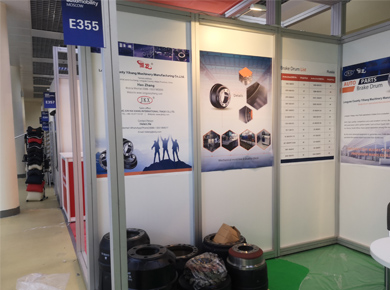Dec . 05, 2024 09:23 Back to list
Understanding Hydraulic E-Brake Systems for Enhanced Drum Brake Performance and Safety
Understanding Hydraulic E-Brake Drums A Comprehensive Overview
In recent years, innovations in automotive technology have drastically improved vehicle safety and performance. One such advancement is the hydraulic e-brake drum system, which integrates the principles of hydraulics with traditional braking mechanisms to enhance efficiency and reliability. This article delves into the workings, advantages, and applications of hydraulic e-brake drums, providing a comprehensive overview of this essential automotive component.
1. The Mechanics of Hydraulic E-Brake Drums
Hydraulic e-brake drums operate on the same principles as conventional drum brakes, where friction is used to slow down or stop the vehicle. However, instead of relying solely on mechanical linkages, these systems utilize hydraulic force generated by a master cylinder. When the driver engages the e-brake, hydraulic fluid is directed to the brake drums, expanding the brake shoes against the interior surface of the drum. This process creates a strong clamping force that effectively halts the wheels.
The hydraulic e-brake system typically consists of several key components the master cylinder, hydraulic lines, brake drums, and brake shoes. The master cylinder is activated by the driver's input, pushing hydraulic fluid through the lines and into the drums. This design provides a more consistent and responsive braking experience compared to traditional systems, where cable tension and mechanical wear can affect performance.
2. Advantages of Hydraulic E-Brake Drums
One of the most significant advantages of hydraulic e-brake drums is their enhanced reliability. Traditional mechanical e-brakes can experience issues such as cable stretching or seizing, leading to diminished performance or complete failure. In contrast, hydraulic systems provide a direct transfer of force, minimizing the risk of such problems. This reliability is particularly crucial for emergency braking situations where immediate response is essential.
Hydraulic e-brake systems also offer better modulation, allowing drivers to control braking force more precisely. This improved feedback enables drivers to apply the brakes in a gradual and controlled manner, reducing the likelihood of locking up the wheels, especially in slippery conditions. Furthermore, hydraulic systems are less susceptible to environmental factors. They are less affected by corrosion or wear, often resulting in lower maintenance costs over the vehicle's lifespan.
hydraulic e brake drums

Additionally, these systems contribute to a more simplified design in modern vehicles, which often feature integrated electronic braking systems. Hydraulic e-brakes can seamlessly connect with advanced features such as anti-lock braking systems (ABS) and electronic stability control (ESC), further enhancing vehicle safety and performance.
3. Applications in the Automotive Industry
Hydraulic e-brake drums are increasingly prevalent in various vehicle types, particularly in electric and hybrid vehicles where weight distribution and space efficiency are paramount. As the industry shifts towards electrification, the need for reliable and efficient braking systems that align with these new technologies becomes even more critical.
Moreover, hydraulic e-brake systems are gaining popularity in high-performance applications, such as sports cars and race vehicles. The enhanced responsiveness and reliability offered by hydraulic systems allow drivers to push their vehicles to the limit without sacrificing safety. Many manufacturers are leveraging this technology to create more engaging driving experiences by integrating hydraulic e-brakes with performance-oriented features.
4. Future Trends and Innovations
As automotive technology continues to evolve, we can expect further advancements in hydraulic e-brake systems. Future innovations may include smarter integration with vehicle systems, leveraging data analytics and sensors to optimize braking performance based on driving conditions. Additionally, the exploration of lightweight materials may lead to even more efficient designs, further improving the overall performance characteristics of hydraulic e-brake drums.
In conclusion, hydraulic e-brake drums represent a significant step forward in automotive braking technology. By combining the reliability and efficiency of hydraulic systems with traditional drum brakes, manufacturers are enhancing vehicle safety and performance. As the automotive landscape evolves, embracing innovative braking solutions like hydraulic e-brake drums will be crucial in adapting to the demands of modern driving while maintaining safety and efficiency. With ongoing advancements, the future of hydraulic e-brake systems looks promising, paving the way for a new era of automotive technology.
-
HINO Industrial Solutions - ¡Ң���ຽ��е��������˾ | Advanced Efficiency&Customization
NewsJul.13,2025
-
HINO Industrial Efficiency Solutions - ¡Ң���ຽ��е��������˾
NewsJul.13,2025
-
HINO Industrial Solutions - ¡Ң���ຽ��е��������˾ | Advanced Technology&Reliability
NewsJul.13,2025
-
HINO Industrial Efficiency-Jiangsu Hino Industrial|Productivity Optimization&Cost Reduction
NewsJul.12,2025
-
HINO-¡Ң���ຽ��е��������˾|Advanced Industrial Solutions&Energy Efficiency
NewsJul.12,2025
-
Premium Brake Drum Iveco – Durable Drum Brake Drum & Brake Shoe Solutions
NewsJul.08,2025
